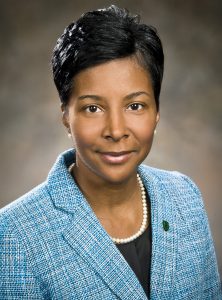
Angela Clements, assistant vice president of advancement in the Wright State University Boonshoft School of Medicine.
The Wright State University Boonshoft School of Medicine has named Angela Clements assistant vice president of advancement. She is responsible for advancing the medical school’s fundraising and alumni engagement efforts and overseeing the Offices of Development and Marketing and Communications.
Clements, who has extensive experience in fundraising and development, most recently served as executive director of development for the Boonshoft School of Medicine, where she restructured the development department and maintained a portfolio of more than 150 prospects. She solicited gifts at the $10,000 to $1 million level and above. She also served as director of major gifts for the medical school from 2012 to 2015. Throughout her career, she has assisted in raising more than $20 million of current, planned and in-kind gifts. She also secured $4.5 million through effective donor cultivation and relationship building.
She came to the university from the Dayton Foundation, where she served as senior development officer. Previously she founded and served as an accountant at a management firm that provided services to not-for-profit organizations and small businesses.
Clements received her bachelor’s degree in business administration from the University of Cincinnati and is a certified public accountant. She is a member of the Association of Fundraising Professionals, the Association of American Medical Colleges – Group on Institutional Advancement and the Council for Advancement and Support of Education. She serves on the Diversity Sub-Committee, Premier Health Partners. She is a board member of the Dayton Metro Library Foundation and is the chair of the Community Engagement Committee. She also serves on the Food Bank Board.
The Wright State University Boonshoft School of Medicine is a community-based medical school affiliated with seven major teaching hospitals in the Dayton area. The medical school educates the next generation of physicians by providing medical education for more than 444 medical students and 443 residents and fellows in 13 specialty areas and 10 subspecialties. Its research enterprise encompasses centers in the basic sciences, epidemiology, public health and community outreach programs. More than 1,500 of the medical school’s 3,229 alumni remain in medical practice in Ohio.

 Wright State supports deaf and hard of hearing community with Deaf Festival
Wright State supports deaf and hard of hearing community with Deaf Festival  Wright State students showcase scientific discoveries at annual research festival
Wright State students showcase scientific discoveries at annual research festival  Wright State medical students bring medicine to life for Mini University preschoolers
Wright State medical students bring medicine to life for Mini University preschoolers  Wright State Theatre to present rom-com musical ‘The Wedding Singer’
Wright State Theatre to present rom-com musical ‘The Wedding Singer’  Heavy metal learning
Heavy metal learning 